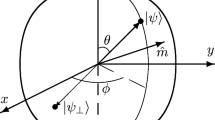Abstract
The concept of a density matrix originated about 1930 in the process of adapting to quantum mechanics the statistical descriptions of classical phenomena. A new light was cast on this concept when Felix Bloch formulated his NMR equation, inclusive of dissipative terms: This equation, ostensibly the time-dependent Schrödinger equation for a spin’s density matrix, governs in fact the expectation values of evolving observables, namely, the components of the spin’s polarization vector. It serves thus as the prototype for manifolds of diverse phenomena. The dissipation (or «relaxation») coefficients of Bloch’s equation and of its analogues were interpreted later by Zwanzig as the expectation values of information streaming away into unobserved sinks.
Riassunto
Il concetto di matrice di densità ebbe origine attorno al 1930 nel corso di adattare alla meccanica quantistica la descrizione statistica di fenomeni classici, ricevendo poi nuova luce dalla formulazione dell’equazione di risonanza nucleare da parte di Felix Bloch, arricchita di effetti dissipativi. Questa equazione, apparentemente l’equazione di Schrödinger per la matrice di densità della polarizzazione di uno spin, guida in realtà i valori medii di ogni quantità osservabile nel corso della sua evoluzione. Essa serve quindi come prototipo per molti e diversi fenomeni. I coefficienti di dissipazione (o «rilassamento») dell’equazione di Bloch vennero poi interpretati da Zwanzig come indici dell’informazione che sfugge per canali non osservati.
Similar content being viewed by others
References
J. von Neumann, Wahrscheinlichkeit theoretischer Aufbau in der Quantenmechanik. Göttinger Nachr., 245, 1927.
J. von Neumann, Thermodynamik quantenmechaniker Gesamtheiten. Göttinger Nachr., 273, 1927.
U. Fano,Description of states in quantum mechanics by density matrix and operator techniques. Rev. Mod. Phys., 29, 1957, 74.
F. Bloch,Nuclear induction. Phys. Rev., 70, 1946, 460.
U. Fano,Precession of a spinning particle in non-uniform fields. Phys. Rev., 133, 1964, B828.
U. Fano,Pairs of two-level systems. Rev. Mod. Phys., 55, 1983, 855.
S. Dattagupta,Relaxation Phenomena in Condensed Matter. Academic Press, Orlando 1987.
R. Zwanzig,Ensemble method in the theory of irreversibility. J. Chem. Phys., 33, 1960, 1338.
H. Feshbach,A unified theory of nuclear reactions II. Ann. of Physics, 19, 1962, 287.
U. Fano -A. R. P. Rau,Atomic Collisions and Spectra. Academic Press, Orlando 1986, sec. 8.6.
Author information
Authors and Affiliations
Additional information
Presentata nella seduta del 3 novembre 1994.
Rights and permissions
About this article
Cite this article
Fano, U. Density matrices as polarization vectors. Rend. Fis. Acc. Lincei 6, 123–130 (1995). https://doi.org/10.1007/BF03001661
Issue Date:
DOI: https://doi.org/10.1007/BF03001661




